


xxxxxThe French painter Auguste Renoir met Claude Monet and Alfred Sisley while studying in Paris in 1862. Together they formed a small group of artists - the Impressionists - who were eager to break free from the strict rules laid down by the artistic hierarchy of the day. They painted out of doors and strove, by rapid, broken brush marks and strong colours to capture the effects of light on a given scene. Renoir succeeded well in this new genre, producing paintings like Regatta at Argenteuil, Dance at Le Moulin de la Galette and The Seine at Asnières, but in the 1880s, after a visit to Italy, he rebelled against the restrictions imposed by this movement. A traditionalist at heart, many of his works - such as Lunch of the Boating Party and Umbrellas - were given greater detail, and outlines were made firmer. And the subject matter became centred around the people or person in the scene rather than the scene itself. By the mid 1880s his works were selling well and, financially secure, he gave much of his time over to the painting of female nudes and charming studies of attractive girls and young women. From the early 1890s his hands suffered progressively from arthritis, but in 1913, with the aid of an assistant, he turned to sculpture and designed a number of fine figures, including his Venus Victrix of 1913.
PIERRE-AUGUSTE RENOIR 1841 - 1919
(Va, Vb, Vc, E7, G5)
Acknowledgements
Renoir: Self-Portrait – Sterling and Francine Clark Art Institute, Williamstown, MA, USA; La Grenouillère – National Museum, Stockholm; Dance at the Moulin de la Galette – Musée d’Orsay, Paris; Boating on the Seine at Asnières – National Gallery, London; Lunch of the Boating Party – Phillips Collection, Washington; Umbrellas – National Gallery, London; On the Terrace – Art Institute, Chicago; The First Outing – National Gallery, London; The Sleeper – Oskar Reinhart Collection, Winterthur, Switzerland; The Doge’s Palace, Venice – Sterling and Francine Clark Art Institute, Williamstown, MA, USA; Vase of Chrysanthemums – Musée des Beaux-Arts, Rouen; Venus Victrix – Tate Gallery, London. Sisley: Lane near a small town – Kunsthalle, Bremen; View of Villeneuve-la-Garenne – Hermitage Museum, St. Petersburg, Flood at Port-Marley – Musée d’Orsay, Paris; Snowy Weather at Veneux-Nadon – Musée d’Orsay, Paris; Bridge at Hampton Court, London – Wallraf-Richartz Museum, Cologne; On the Cliffs, Langland Bay, Wales – Musée des Beaux Arts, Rouen.
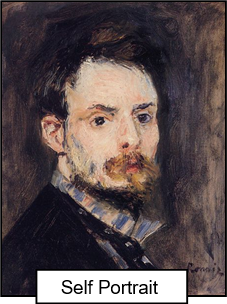 xxxxxThe French painter Pierre-Auguste Renoir studied at the Académie des Beaux Arts in Paris and it was there, in 1862, that he met Claude Monet and Alfred Sisley. They formed the nucleus of the movement which came to be known as Impressionism, a style of painting which attempted to capture, by rapid, broken brushwork and the use of strong, pure colours, the spontaneity and atmosphere of an ordinary everyday scene, be it a landscape, a café scene, a boat trip on the river, or a railway station. In a short time other young artists joined them - notably Pissarro and Cezanne - all anxious to break away from the strict rules and elevated subjects imposed by the Salon in Paris. Given time, Renoir proved to be an independent artist with his own agenda, but for a period he was a chief exponent of this movement’s aims and ideals.
xxxxxThe French painter Pierre-Auguste Renoir studied at the Académie des Beaux Arts in Paris and it was there, in 1862, that he met Claude Monet and Alfred Sisley. They formed the nucleus of the movement which came to be known as Impressionism, a style of painting which attempted to capture, by rapid, broken brushwork and the use of strong, pure colours, the spontaneity and atmosphere of an ordinary everyday scene, be it a landscape, a café scene, a boat trip on the river, or a railway station. In a short time other young artists joined them - notably Pissarro and Cezanne - all anxious to break away from the strict rules and elevated subjects imposed by the Salon in Paris. Given time, Renoir proved to be an independent artist with his own agenda, but for a period he was a chief exponent of this movement’s aims and ideals.
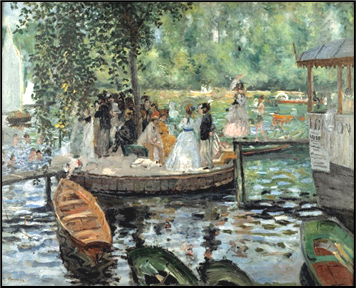 xxxxxHe was born at Limoges in southern-central France and when, at the age of 14, his family moved to Paris, he began his artistic career decorating dishes in a china factory and painting designs on fans, lampshades and screens. After completing his studies at the Academy, he worked with Monet at La Grenouillière, a bathing place on the Seine, in the late 1860s, painting outdoors and producing, together with him, some of the finest examples of this pioneering genre. To this period belongs his La Grenouillère (illustrated), a work which, via his delicate touch and firm brushwork, shows a clear appreciation of this new art form, its spontaneity and, in particular, its fascination with the effects of light.
xxxxxHe was born at Limoges in southern-central France and when, at the age of 14, his family moved to Paris, he began his artistic career decorating dishes in a china factory and painting designs on fans, lampshades and screens. After completing his studies at the Academy, he worked with Monet at La Grenouillière, a bathing place on the Seine, in the late 1860s, painting outdoors and producing, together with him, some of the finest examples of this pioneering genre. To this period belongs his La Grenouillère (illustrated), a work which, via his delicate touch and firm brushwork, shows a clear appreciation of this new art form, its spontaneity and, in particular, its fascination with the effects of light.
xxxxxAfter the Franco-Prussian War of 1870-71, during which he served in the cavalry but saw no action, he joined a group of like-minded friends (including Monet), and in 1874 took part in its first exhibition. Over the next six years or more the avant-garde works of the “Impressionists”, as they now came to be called, came in for some stern criticism and virulent abuse, but Renoir remained a strong supporter of the movement, and his paintings of this period, particularly his riverside scenes, were truly impressionist, capturing the atmosphere as in a moment of time. Notable in this respect was his picture of Claude Monet painting in his Garden at Argenteuil, Regatta at Argenteuil, Dance at Le Moulin de la Galette and Boating on the Seine at Asnières (the last two illustrated below). However, in many of his works of this period, such as The Theatre Box, The Swing, and Girl with a Watering Can, the subject matter was as important as the technique he employed. He was not really a landscape artist. He preferred painting people, particularly young, innocent girls, and from his early days he had also shown an interest in the female nude, such as his Diana the Huntress of 1867. Furthermore, his charming painting of 1878 entitled Madame Charpentier and her Children showed his undoubted talent as a portrait painter, as, indeed, had his earlier studies of Sisley and Monet. It was well reviewed and led to a growing demand for his paintings.

Vb-1862-1880-Vb-1862-1880-Vb-1862-1880-Vb-1862-1880-Vb-1862-1880-Vb-1862-1880-Vb
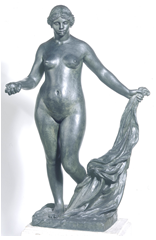 xxxxxBy the mid-1880s his paintings were selling well and the female nude soon became his primary subject, portrayed in the warmer, vibrant colours of his earlier work. And alongside these well-rounded figures went a number of self-portraits and some charming, intimate studies of young girls, such as Girls at the Piano, The Reading, and Girl Combing Her Hair. By the early 1890s, however, he began to suffer from arthritis, particularly in his hands, and this complaint became progressively worse as he became older. Whilst he maintained the quality of his work, he was often in a great deal of pain, and this slowed down his output. To gain the comfort of a warmer climate, in 1905 he moved to Cagnes, near Nice on the Mediterranean coast, and it was there that he died of a heart attack in December 1919. It was worth noting that in the last six years of his life he turned to sculpture, and with the aid of an Italian assistant, produced a number figures, including his Venus Victrix of 1913 (illustrated).
xxxxxBy the mid-1880s his paintings were selling well and the female nude soon became his primary subject, portrayed in the warmer, vibrant colours of his earlier work. And alongside these well-rounded figures went a number of self-portraits and some charming, intimate studies of young girls, such as Girls at the Piano, The Reading, and Girl Combing Her Hair. By the early 1890s, however, he began to suffer from arthritis, particularly in his hands, and this complaint became progressively worse as he became older. Whilst he maintained the quality of his work, he was often in a great deal of pain, and this slowed down his output. To gain the comfort of a warmer climate, in 1905 he moved to Cagnes, near Nice on the Mediterranean coast, and it was there that he died of a heart attack in December 1919. It was worth noting that in the last six years of his life he turned to sculpture, and with the aid of an Italian assistant, produced a number figures, including his Venus Victrix of 1913 (illustrated).
xxxxxAmong his many outstanding works are Le Pont Neuf of 1872, a snapshot in depth of a busy scene on a Sunday afternoon; The First Outing of 1876, which captures so cleverly the feeling of excitement felt by a young girl on her first visit to the theatre; The Sleeper of 1897, a soft, sensuous work; The Doge’s Palace, a sparkling impression of a famous scene, painted during his visit to Venice in 1881; and Vase of Chrysanthemums of 1895, one of the many brilliant still lifes he produced during his long career (the last four illustrated below).
xxxxxRenoir contributed a great deal to Impressionism, particularly by the exuberance of his palette and by the brilliant way in which he handled the effects of the interplay between light and colour. However, whilst he produced some landscapes to achieve the movement’s aims, his main interest lay in the portrayal of people and the activity in which they were involved. Most of his works contained a group of people or, at least, a single person. In this respect he excelled in figure painting, producing intimate graceful studies of the female nude and charming, sensitive portraits of young girls or attractive young women. He was one of the most successful of the Impressionists, but his fame rests also upon his individuality as an artist, both in style and subject matter.
xxxxxThe French artist Alfred Sisley (1839-1899) met Monet and Renoir while studying in Paris in 1862. He was attracted by their ideas and with others (notably Cézanne, Pissarro and Manet) joined them in what came to be known as the Impressionist movement - aimed at capturing, by painting out of doors, a momentary glimpse of an everyday scene. Confining himself almost exclusively to landscape painting, he kept faith with this idea. Whilst others, like Renoir and Cézanne, found this new art form too restrictive and came to introduce their own individual style, he developed impressionism. By his sensitive handling of light and his use of soft, harmonious tones he created an atmosphere of freshness and beauty. In his day, however, this unique contribution was not appreciated. He was just seen as an artist painting in the style of Monet. As a result he struggled to make ends meet. Not until after his death was he recognised as an innovative founder of the movement. Among his major works - all painted in the area of Fontainebleau, west of Paris, were The Bridge, Boats at Bougival Lock, The Square at Louveciennes, Snow at Louveciennes and Flooding at Port Marly - from the 1870s - and, in later life, Loing Canal at St. Mammes, Moret on the Loing, Lane of Poplars at Moret, The Bridge at Moret and Matrat’s Boatyard. He visited England in 1874 and produced some twenty paintings of the Thames, including The Bridge at Hampton Court.
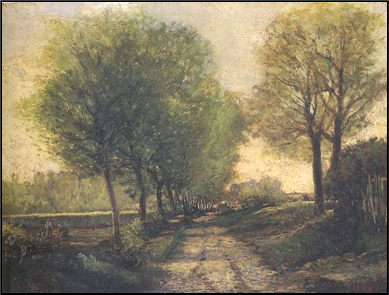 xxxxxThe artist Alfred Sisley (1839-1899) met Auguste Renoir, together with Claude Monet and Frédéric Bazille, in the early 1860s when they were students at the Académie des Beaux Arts in Paris. They all became close friends and, on completing their studies, formed a group of young artists committed to painting outdoors in order to capture - by bold colours and broken, energetic brushwork - a fleeting image of a country scene. This was the start of the movement which came to be known as Impressionism. For a number of years they and other “Impressionists” - including Paul Cézanne, Camille Pissarro and Édouard Manet - worked together, painting realistic glimpses of the countryside in and around the forest of Fontainebleau, just west of Paris. Later, Renoir and some of his other friends moved away from the strict aims of the movement, but Sisley, keeping almost entirely to landscape painting, maintained his interest in the new art form. His works gained little if any recognition in his day, but he is now regarded as one of the founders of the movement
xxxxxThe artist Alfred Sisley (1839-1899) met Auguste Renoir, together with Claude Monet and Frédéric Bazille, in the early 1860s when they were students at the Académie des Beaux Arts in Paris. They all became close friends and, on completing their studies, formed a group of young artists committed to painting outdoors in order to capture - by bold colours and broken, energetic brushwork - a fleeting image of a country scene. This was the start of the movement which came to be known as Impressionism. For a number of years they and other “Impressionists” - including Paul Cézanne, Camille Pissarro and Édouard Manet - worked together, painting realistic glimpses of the countryside in and around the forest of Fontainebleau, just west of Paris. Later, Renoir and some of his other friends moved away from the strict aims of the movement, but Sisley, keeping almost entirely to landscape painting, maintained his interest in the new art form. His works gained little if any recognition in his day, but he is now regarded as one of the founders of the movement
xxxxxSisley was born in Paris of English parents, but he spent almost his entire life in France. At the age of 18 his father, a wealthy silk merchant, sent him to London to start a career in business, but it soon became clear that he was not cut out for a life in commerce. In 1861, with the permission of his father, he returned to Paris to study art. It was then that, via his friendship with Monet and Renoir and his visits to the Café Guerbois - a famous meeting place for rebel artists - he was drawn into Impressionism. The aims and ideals of the movement attracted him, and for the remainder of the 1860s he worked alongside its members, painting outdoors and trying to capture the transient effects of light at locations around Fontainebleau - such Chailly-en-Bire, Marlotte and Saint Cloud. His paintings at this time included Lane near a Small Town, produced about 1864, (illustrated above), and his Village Street in Marlotte two years later. At this stage he worked with a toned down palette and his style owed something to Camille Corot and members of the Barbizon School.
xxxxxTwo of his landscapes were accepted for the Salon of 1866, and in 1870 he settled at Louveciennes, just west of Paris, a favourite haunt of the Impressionists. That year, however, saw the outbreak of the Franco-Prussian War and this brought disaster in its wake. The Prussian army overran the family estate in Bougival and brought about the downfall of his father’s business. For Sisley it meant the end of a generous allowance and, as it worked out, a life of desperate poverty. He returned to Louveciennes after the war, fully aware that he was dependent upon his painting to make a living. He exhibited with the Impressionists throughout the 1870s and, under the influence of Monet, his colour contrasts became stronger and he gave greater attention to the transient effects of light. It was during this period that he produced some of his finest works, his series of landscapes now regarded as outstanding examples of impressionism. Notable in this respect are View of Villeneuve-la-Garenne of 1872, and Flood at Port-Marly of 1876 - one of seven versions - both illustrated below.
xxxxxOther works of this period included The bridge at Argenteuil of 1872 (bought by Manet), Boats at Bougival Lock of 1873, The Square at Louveciennes and The Canal of 1874, Snow at Luveciennes of 1875, and The Bridge at Sèvres, painted about 1877.
xxxxxBut outstanding though these impressionist paintings were, they attracted little attention and brought no financial reward - and this was to be the case for the remainder of his career. In his day he was simply regarded as an artist painting in the style of Monet. In fact, as was later appreciated, his peaceful landscapes were remarkable for their gentle, soft interpretation. And although his composition was simple, and there was little variety in his choice of subject matter - he tended to concentrate on river scenes, bridges, avenues of trees, and views of distant countryside - there was a sensitivity about his work which was not to be found amongst the other Impressionists. By his lightness of touch, his subtle handling of light, and his use of soft, harmonious colours, he created an atmosphere of freshness, tranquillity and beauty.
xxxxxFrom the early 1880s he was living in or around a small village near Moret-sur-Loing, close to the forest of Fontainebleau, - an area frequented earlier by members of the Barbizon school. He was at home in this peaceful setting, painting outdoors in all seasons and capturing the atmosphere of each scene, sometimes in a number of versions. He never hankered after dramatic seascapes, as did Monet, nor was he interested in figure painting, like Renoir and Pissarro, but during the last twenty years of his life he produced a string of now famous landscapes, composed with a greater degree of freedom and a more vigorous use of colour.
xxxxxDuring the 1880s these later works included Snowy Weather at Veneux-Nadon (illustrated left above), Courtyard in a Farm at St. Mammes, Loing Canal at St. Mammes, Moret on the Loing, Lane of Poplars at Moret, and Flooding at Moret. Notable works in the 1890s included On the Banks of the Loing, The Bridge at Moret, Setting Sun at Moret, Moret on the Loing at Sunrise, The Loing Canal at Moret, and Matrat’s Boatyard. In these, as in his earlier works, he showed a passionate interest in the composition of the sky, and some show his fascination with the effects of snow upon a given scene.
xxxxxSisley spent almost his entire life in or around The Île de France (the Paris region), but, backed financially by his patrons, he did make two brief visits to England. In the first one, in 1874, he produced nearly twenty paintings of the Thames, and these included The Bridge at Hampton Court (illustrated centre above). Then in 1897 he and his partner visited Wales. They stayed at Penarth, a seaside resort near Cardiff and, on that occasion, he did paint several views of the seashore, including The Bristol Channel near Penarth and On the Cliffs, Langland Bay, Wales (illustrated right above).
xxxxxSisley, a quiet, modest man, was devoted to his art. His landscapes contained no social or political message, they were simply meant to delight the viewer by their simplicity and beauty. And this they did. As a founder member of the Impressionists, he admirably expressed the aims and ideas of the movement, and, by his delicacy of touch, added to its width. He died of throat cancer in 1899, aged 59, and was buried at Moret-sur-Loing, having never received the recognition he so richly deserved. A year after his death one of his paintings sold for 43,000 francs.
xxxxxIncidentally, although he spent his life in France and played so important a part in a movement which had its roots firmly in that country, he remained British. After being refused French citizenship in 1898, he made a second application, supported by a police report, but he was then taken ill and died before a decision was made. ……
xxxxx…… In 1866 Sisley began a relationship with Eugénie Lescouezec, a florist and an artist’s model living in Paris, and they had two children, Pierre and Jeanne. They let it be assumed that they were married, but in fact they were married at Cardiff Registry Office during his visit to Wales in 1897, mainly to ensure that his paintings would be inherited by their children. She died in October 1898, just three months before his own death.
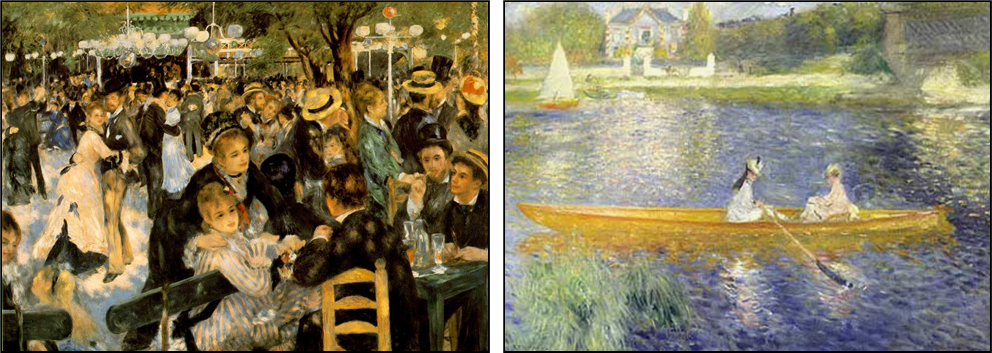
xxxxxAnd despite his admirable contribution to the Impressionist movement, Renoir was, at heart, a traditionalist, an admirer of the old masters. Thus by 1880, somewhat wearied and frustrated, he had come to the conclusion that as an art form Impressionism was too restrictive. And this view was patently reinforced by subsequent events. In 1881 he paid a visit to North Africa in the steps of Eugène Delacroix (a colourist much admired by the Impressionists) and then travelled to Italy. During his stay there he admired the works of the Renaissance masters, especially those of Raphael, and during a visit to Naples he was deeply impressed by the exhibition of Roman paintings from Pompeii and Herculaneum. Then, on his return via Marseilles, he stayed for a while with his close friend Paul Cézanne, then living at L’Estaque, a small village a few miles west of the city. Though labelled an Impressionist - and rightly so in some respects - Cézanne also saw limitations in the ideals of the movement, and was anxious, by innovation, to make it “something solid and lasting”.
xxxxxAs a result, on his return (delayed by a serious attack of pneumonia) Renoir adopted a more classical, disciplined approach, clearly to be seen in the large number of scenes from everyday life that he produced in the 1880s. These included his Lunch of the Boating Party, Umbrellas, and On the Terrace (all three illustrated below), and Girl with a Hoop. Among his nudes of this period were Seated Girl, The Bathers, and After the Bath. These works still owed much to Impressionism, but now there was more attention to detail, outlines were a great deal firmer, and many were completed in the studio. And much more emphasis was placed on people in the scene rather than the composition of the scene itself.
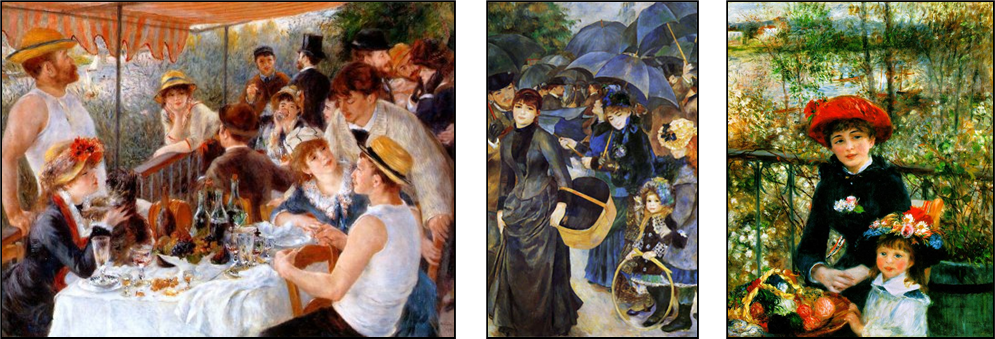

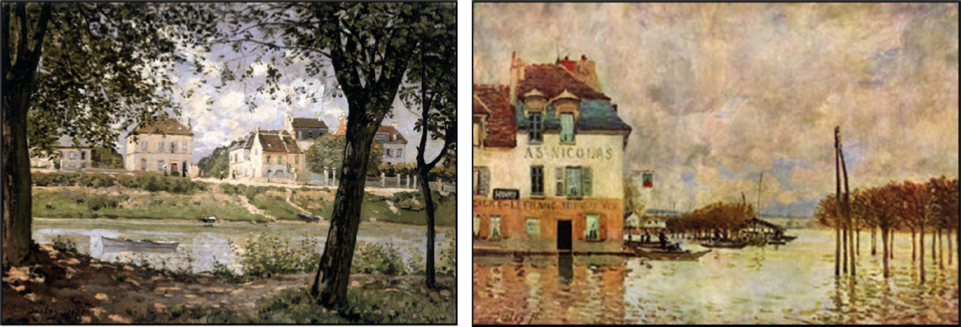







 xxxxxThe French painter Pierre-
xxxxxThe French painter Pierre- xxxxxHe was born at Limoges in southern-
xxxxxHe was born at Limoges in southern-
 xxxxxBy the mid-
xxxxxBy the mid- xxxxxThe artist Alfred Sisley (1839-
xxxxxThe artist Alfred Sisley (1839-






